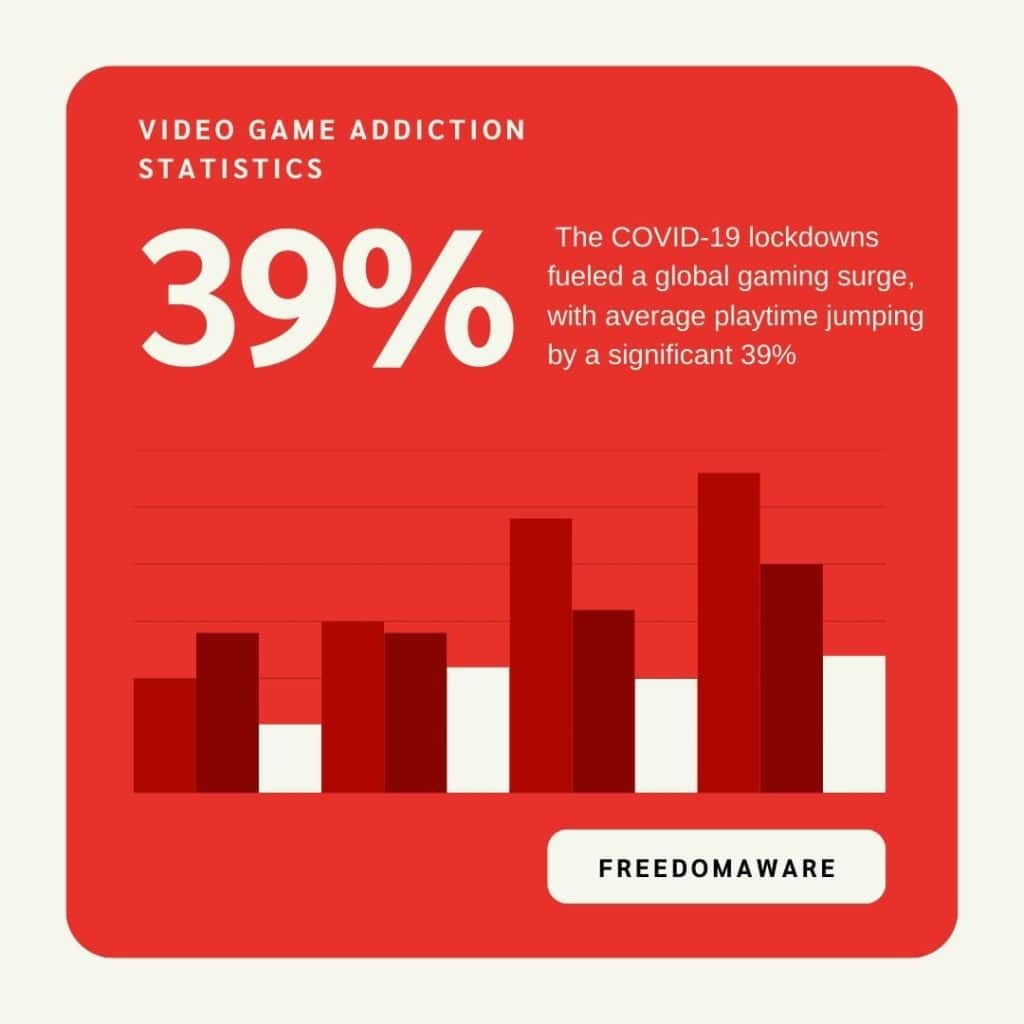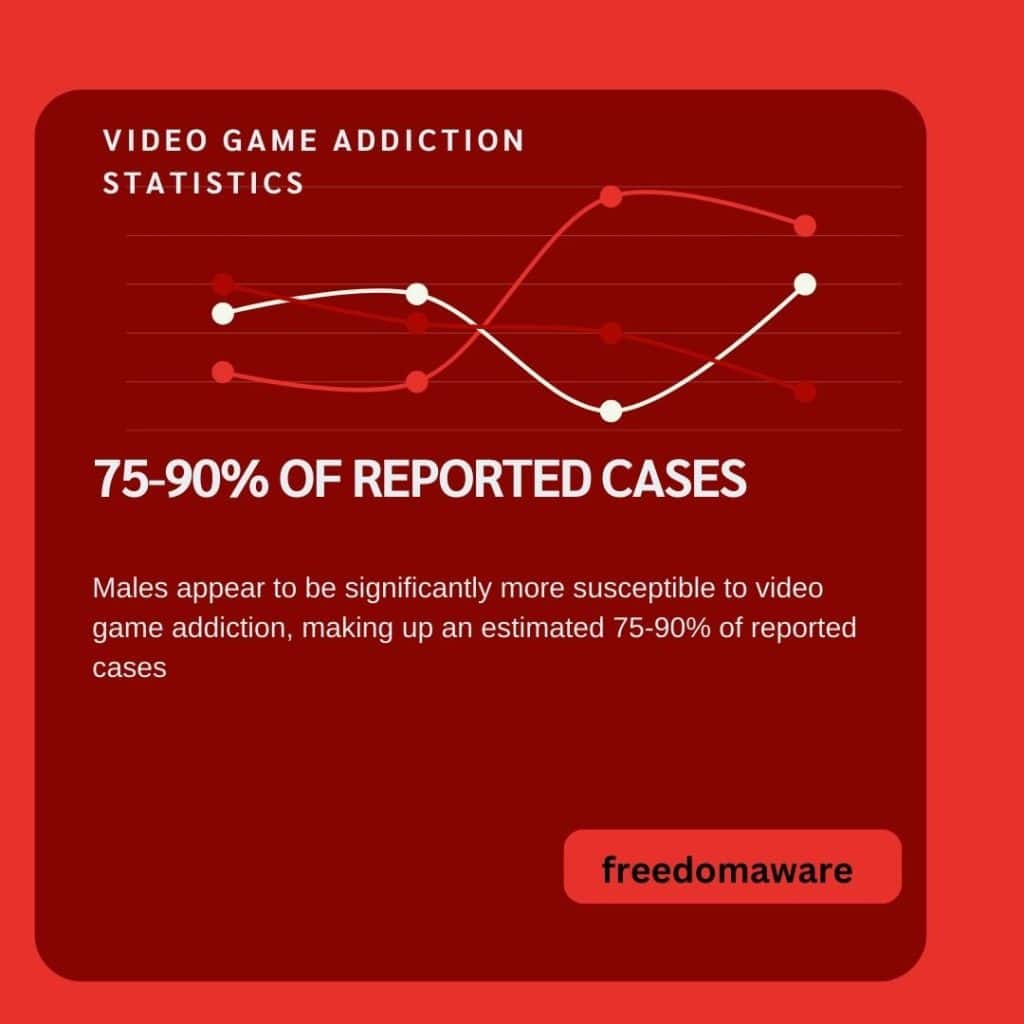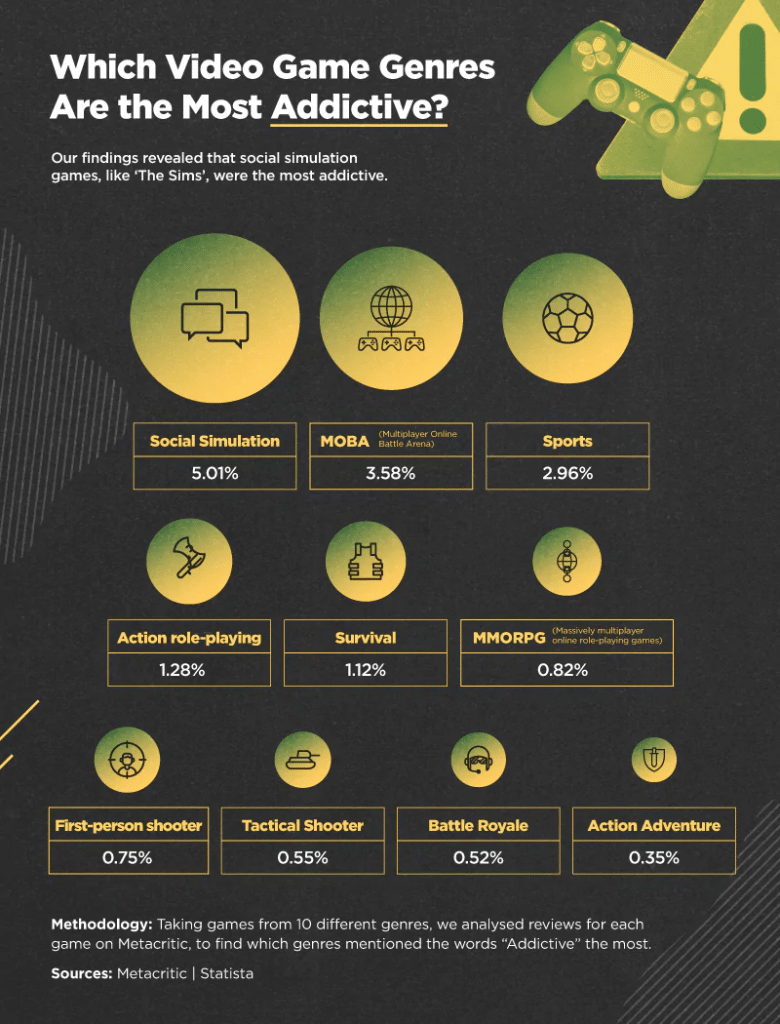
Here are some video game addiction statistics, facts, and trends to help you in 2024 and beyond;
Buckle Up: Diving Deep into Video Game Addiction
Video games: fun pastime or potential pitfall? Let’s enjoy the wild world of video game addiction statistics!
We’re all familiar with that feeling – when gaming goes from a casual hobby to a full-on obsession. The line between enjoyment and addiction can be blurry. But video game addiction, also known as Internet Gaming Disorder (IDG), is a real issue with growing recognition.
The WHO classified it as a mental health disorder in 2022. Now, that’s a game-changer!
But what does this all mean? Here’s the scoop: we’ve got 82 eye-opening video game addiction statistics to shed light on what’s happening behind the screen. Forget dry numbers – this is like peering into the unfiltered world of our gaming habits.
So, grab your controller (figuratively, for now) and get ready for a real talk about the ups and downs of video gaming. Let’s keep it honest!

Game Over? A Look at Video Game Addiction Numbers
Here’s a breakdown of some key stats on video game addiction:
- Millions in the Game: A staggering 60 million people worldwide are estimated to be struggling with gaming disorders.
- A Gender Gap: Guys seem to be more susceptible, with 75-90% of video game addiction cases affecting males.
- The 3-4% Club: Around 3-4% of gamers globally are battling internet gaming disorders.
- The Daily Grind: If you’re clocking over 10 hours a day or 30 hours a week on video games, it might be time to re-evaluate your habits – that’s considered addiction territory.
- Multiplayer Mania: In the US, 22% of gamers spend a massive chunk (61-80%) of their gaming time on multiplayer games. Talk about teamwork (or team obsession)
- Rocket Woes: Rocket League currently holds the crown for the most addictive game, with over 14.5% of reviewers labeling it so.
- Teens at Risk: Adolescence seems to be a vulnerable time, with video game addiction rates ranging from 4% to a concerning 20% among young people.
Global Video Game Addiction Statistics
Unveiling the Video Game Landscape ( Video Game Addiction Statistics ): Stats and Trends
Here’s a breakdown of some key statistics and trends shaping the world of video games:
- Millions in the Game: A staggering 60 million people globally are estimated to be struggling with gaming disorders (source).
- Gaming on the Rise: The video game market is booming, with projected revenue reaching a whopping $282.3 billion in 2024 and expected to keep growing at a healthy clip (source).
- By 2027, the market is expected to be worth a cool $363.2 billion! (source)
- Global Gamer Growth: The number of video game users is projected to climb to a massive 1.4 billion by 2027 (source). Get ready for some serious online competition!
- Scientific Studies Confirm: A 2021 scientific review found a global prevalence of gaming disorder around 3.05% (source).
- US Gamers Take Charge: The United States boasts a hefty online gaming population, with an estimated 160 million adults playing online games (source).
- UK Gamers on the Rise: The UK gaming scene is thriving, with the number of video game users expected to reach a significant 57.56 million by 2027 (source).
- Where’s the Line? Spending over 10 hours a day or 30 hours a week on video games is considered addiction territory (source). Remember, moderation is key!
- Average Gamers: The typical video gamer enjoys about 6 hours of playtime each week (source).
- Teens and Tech: Teenagers spend a significant amount of time on video games, averaging almost 2 hours daily (source).
- At-Risk Population: It’s important to note that between 0.3% and 1% of the general population experience symptoms linked to gaming disorder (source).
- Warning Signs: Preoccupation with gaming is a red flag for potential video game addiction (source). Be mindful of your gaming habits and their impact on your life.
Video Games: The Good, the Bad, and the Playtime
Here’s a look at some interesting trends and potential drawbacks of video games:

- Pandemic Play Boost: The COVID-19 lockdowns fueled a global gaming surge, with average playtime jumping by a significant 39% (source).

- South Korea’s Gaming Economy: In South Korea, video game addiction comes with a hefty price tag – an estimated annual cost of $3.5 billion. (source)
- However, the gaming industry there also generates a substantial annual gain of $24.3 billion (source). Interesting duality!
- US vs. Global Playtime: American gamers clock in at an average of 7.71 hours per week, while the global average sits slightly higher at 8.45 hours (source). Who are the world champions of playtime?
- Lockdown Loneliness and Lost Hygiene: A concerning statistic: around 30% of Britons reportedly skipped meals and showers during the 2020 lockdowns in favor of video games (source). Remember, self-care is important!
- Gender Gap in Gaming Disorders: Men seem to be more susceptible to gaming disorders compared to women (source).
- Gamers vs. Addicted Gamers: The average gamer is 35 years old, while someone struggling with a gaming addiction is typically younger, around 24 years old (source).
- WHO Sounds the Alarm: According to the World Health Organization, an estimated 3% of the global population suffers from internet gaming disorder (source).
Age and Addiction (Video Game Addiction Statistics): Who’s Most at Risk?
While anyone can develop a gaming addiction, some age groups seem to be more susceptible:

- Teens and Tech Addiction: Teens appear to be particularly vulnerable, with the prevalence of video game addiction among them rising by 4% since 2007 (source). It’s important to find a healthy balance.
- The Multiplayer Mindset: A significant portion of American gamers (22%) dedicate a massive chunk of their playtime (61-80%) to multiplayer games (source). This intense focus on online competition can have implications for how people interact and prioritize activities.
- Sleepless in Seattle (or Anywhere You Game): A survey revealed a concerning trend: 67% of gamers admitted to frequently sacrificing sleep for continued gaming sessions (source). Remember, a healthy sleep schedule is crucial for overall well-being.
- The Dark Side of the Game: Research suggests a link between internet gaming disorder and difficulties with decision-making, impulse control, and emotional regulation (source). These challenges can affect various aspects of life.
- Mental Health Concerns: Video game addiction can be a contributing factor to sleep disorders, depression, and anxiety (source). It’s important to seek help if you’re experiencing these issues.
- The Vast Majority: Thankfully, the vast majority of gamers (90%) don’t exhibit dangerous or long-term problematic behaviors related to gaming (source). This is a positive takeaway!
Top Contenders (Video Game Addiction Statistics): The Games Gamers Can’t Quit
While enjoyment is a core part of gaming, some titles seem to be particularly captivating:
- Rocket League Takes the Crown: Currently, Rocket League reigns supreme as the most addictive game, with a whopping 14.53% of reviewers labeling it so (source). Buckle up for intense car-soccer action!
- Littlewood Lures You In: Littlewood nabs the second spot, with 12.50% of reviewers finding it highly addictive (source). This game might be more captivating than you bargained for!
- Animal Crossing: Charmingly Addictive?: Believe it or not, the seemingly peaceful Animal Crossing: New Horizons makes the list at number 13, with 1.58% of reviewers finding it addictive (source). Who knew island life could be so engrossing?
- The Sims 4: Not Quite as Gripping: The Sims 4, known for its life simulation gameplay, sits lower on the list with only 0.97% of reviewers tagging it as addictive (source). It seems managing virtual lives can be slightly less captivating than some other options.
- Dota 2: The Moderate Challenge?: Dota 2, a popular online battle arena game, sits at a score of 1.68% of reviewers finding it addictive (source). This suggests a slightly lower potential to become all-consuming compared to the top contenders.
- Tom Clancy’s Rainbow Six Siege: A Strategic Simmer?: Tom Clancy’s Rainbow Six Siege nabs a spot with 2.02% of reviewers labeling it addictive (source). The strategic elements might provide a different kind of appeal compared to fast-paced action games.
- The Elder Scrolls V: Skyrim: A Moderately Enchanting Adventure?: The Elder Scrolls V: Skyrim, a sprawling open-world RPG, comes in with 1.35% of reviewers finding it addictive (source). The vast world might offer a captivating experience, but perhaps at a slower pace.
- Counter-Strike: Global Offensive: Strategic Sprays (and Not-So-Addictive Plays?) Counter-Strike: Global Offensive, another popular online shooter, sits at 1.27% of reviewers considering it addictive (source). The tactical gameplay might provide a strategic challenge without necessarily being all-consuming.
- Fallout 3: Post-Apocalyptic Appeal (But Not Overly Gripping): Fallout 3, a post-apocalyptic RPG, scores 1.28% of reviewers finding it addictive (source). The unique setting offers a different kind of immersion, but perhaps with a less intense hold on players.
- Call of Duty Black Ops III: A Soldier’s Life (With Moderate Captivation): Call of Duty Black Ops III, a first-person shooter, rounds out the list with 1.22% of reviewers labeling it addictive (source). The action-packed gameplay might be moderately captivating, but not necessarily lead to uncontrollable play sessions.
- The Demigod Dilemma: Demigod comes in third place, with 10.77% of reviewers finding it addictive (source). Be warned – this game might have a godlike hold on your playtime!
- Stardew Valley’s Allure: Stardew Valley, the charming farming simulator, nabs the fourth spot with 6.67% of reviewers labeling it addictive (source). Don’t underestimate the captivating pull of virtual farm life!
- League of Legends: Competitive Craving?: League of Legends, a popular online battle arena game, sits at number five with 4.28% of reviewers finding it addictive (source). The competitive nature might be what keeps players hooked.
- Path of Exile: Less is More (Relatively Speaking): Path of Exile holds the interesting distinction of having a negative addiction score (-3.60%) based on reviewer data (source). This suggests it’s less likely to be seen as highly addictive compared to other games on the list.
- My Time at Portia: Crafting Calmly?: My Time at Portia, a relaxing crafting and simulation game, scores 3.33% on the reviewer addiction scale (source). The laid-back gameplay might offer a more chill experience.
- Fortnite: Not Quite a Frenzy?: Fortnite, the popular battle royale game, comes in at 2.59% of reviewers finding it addictive (source). This suggests it might be less likely to trigger uncontrollable play sessions compared to some other entries.
- Planetside 2: Large-Scale Battles (Without Extreme Addiction?): Planetside 2, a large-scale online shooter, nabs a spot with 2.38% of reviewers labeling it addictive (source). The focus on large-scale battles might offer a different kind of appeal, potentially with less individual player obsession.
- Frostpunk: The Management Challenge (Not the Addiction Trap): Frostpunk, a city-building survival game, scores 3.89% on the reviewer addiction scale (source). The strategic management aspects might provide a different kind of engagement, potentially with less risk of excessive play.
- The Realm of MMORPGs: According to Statista, the massive multiplayer online role-playing genre (MMORPG) takes the crown as the genre with the highest perceived addiction risk (source). These vast online worlds can be incredibly captivating.
- MOBA: The Thrill of Competition: Multiplayer Online Battle Arena (MOBA) games, known for their intense team-based battles, also rank high in perceived addiction risk (source). The competitive nature and strategic depth can be highly engaging.
- Beyond the Top Contenders: (source) Here’s a look at how other genres fare on the addiction scale (all based on reviewer data):
- Social Simulation: 5.92%
- MOBA Battle Arena: 3.58% (slightly lower risk than standard MOBAs)
- Multiplayer Online Sports: 2.96%
- Action Role-playing: 1.28%
- Survival: 1.12%
- Tactical Shooter: 0.55%
- Action Adventure: 0.35% (considered low risk)
- Battle Royale: 0.52% (lower risk than standard MOBAs)
- First-person Shooter: 0.75%
Gender Gap in Gaming Addiction (Video Game Addiction Statistics)
While anyone can develop a gaming addiction, research suggests a gender disparity:

- Men at Higher Risk: Males appear to be significantly more susceptible to video game addiction, making up an estimated 75-90% of reported cases (source).
- Women and Gaming Addiction: Women are not immune, but they account for a smaller portion of cases, at around 10-25% (source). It’s important to note that these are general trends, and individual experiences can vary.
Age and Vulnerability (Video Game Addiction Statistics): Who’s Most at Risk for Video Game Addiction?
While video game addiction can affect anyone, certain age groups seem to be more susceptible:
- Children and Gaming: Among children aged 8-18, an estimated 8.5% are grappling with video game addiction (source). This highlights the importance of parental guidance and healthy gaming habits for younger players.
- The Teenage Tech Trap: Adolescence, particularly between 13-18 years old, appears to be a prime time for video game addiction, with prevalence rates ranging from 4% to a concerning 20% (source).
- Young Adults and Gaming: Young adults (18-24 years) also face significant risk, with studies reporting addiction rates between 5% and 10% (source). Balancing gaming with other life responsibilities becomes crucial during this period.
- Gaming Across Generations: Even adults aged 25 and above can experience video game addiction, with prevalence rates varying from 2% to 5% (source). It’s a reminder that responsible gaming practices are important for all ages.
Global Gaming Landscape (Video Game Addiction Statistics): Addiction Rates Around the World
Video game addiction is a concern that transcends national borders. Here’s a glimpse into the situation in different countries:
- The UK Gaming Scene: An estimated 700,000 to 1 million UK gamers, roughly 2-3% of the population, struggle with video game addiction (source).
- This highlights the issue’s prevalence. However, it’s important to note that over a quarter (26%) of UK adults play online games casually, averaging 1-5 hours per week (source).
- Before lockdowns, the average UK gamer spent a more significant chunk of time playing, clocking in at 13 hours weekly (source). This suggests a potential pre-lockdown issue with excessive gaming habits.
- Australia’s Gaming Landscape: A study by Macquarie University revealed that 2.8% of Australian adolescents meet the criteria for internet gaming disorder (source).
- Interestingly, the study also found a significant gender gap, with boys (96%) being far more likely to be addicted than girls (6%) (source).
- Despite this, video games remain popular in Australia, with 67% of the population playing regularly and averaging 89 minutes of daily playtime (source).
- Gaming addiction rates were higher among males than females, with 96% of boys and 6% of girls exhibiting addiction tendencies. (source)
- Approximately 67% of Australians engage in regular video game play, dedicating an average of 89 minutes to gaming daily. (source)
- The government of Japan has officially recognized video game addiction as a public health concern. (source)
- Research indicates that Singaporean teenagers devote more time to gaming compared to their American counterparts, spending 20 and 13 hours on average, respectively. (source)
- In Taiwan, a 2018 survey revealed that around 6% of adolescents exhibited severe addiction to online gaming. (source)
- A survey conducted in Thailand identified video game addiction among children aged 6 to 18 years old. (source)

The Global Gaming Landscape (Video Game Addiction Statistics): Players, Risks, and Rewards
The world of video games is booming! Here’s a look at some interesting trends:
- Gamers on the Rise: Over two billion people worldwide play video games, and that number is projected to hit a staggering three billion by 2023 (source).
- The Grip of Gaming: While most gamers enjoy a healthy balance, a small percentage struggle with addiction. Estimates suggest that up to 4% of gamers and 3.05% of the global population experience gaming disorder (source). This translates to roughly 60 million people worldwide.
- Not Everyone Gets Hooked: It’s important to remember that addiction is not the norm. While some people might exhibit symptoms associated with gaming disorder (between 0.3% and 1% of the general population), responsible gaming is the reality for the vast majority (source).
- In the US, for instance, only 10% of adults who play video games consider themselves avid gamers (source).
- The Allure of the Game: Games can be truly engaging! The dopamine rush experienced while playing is a well-documented phenomenon (source).
- Thankfully, most gamers (around 90%) don’t exhibit dangerous or long-term negative behaviors due to their playtime (source).
Video Games (Video Game Addiction Statistics): A Global Phenomenon with Potential Challenges
The world of video games is vast and ever-changing. Here’s a look at some interesting trends and potential issues:
- The Pandemic Playtime Boom: Lockdowns fueled a global gaming surge, with the average playtime jumping a significant 39% (source).
- Gaming and ADHD: A Link to Consider: Research suggests a connection between symptoms of ADHD and varying levels of video game addiction (source). It’s important to consult a healthcare professional if you suspect ADHD.
- Gaming Disorder on the Rise: The worldwide prevalence of gaming disorder reached 3% in 2019 (source), highlighting a growing concern.
- The American Gamer: The average American gamer spends 7.71 hours per week playing video games (source). Finding a healthy balance is key.
- A Global Perspective: Studies show that between 0.3% and 1% of the general population worldwide exhibit signs of internet gaming disorder (source).
- Lockdown’s Dark Side: A concerning statistic emerged during the 2020 lockdowns: around 30% of Britons reportedly neglected meals and showers in favor of video games (source). Prioritizing self-care is crucial.
- Gaming Rules in China: China enforces stricter regulations on youth gaming, limiting weekday playtime to 90 minutes (source).
- Growth of Gaming Disorder: A large-scale study spanning 2009 to 2019 revealed a 3% increase in the global prevalence of gaming disorders by 2019 (source). This suggests a need for awareness and responsible gaming practices.

Navigating the Gaming Landscape (Video Game Addiction Statistics): Stats, Trends, and Age Groups
The world of video games is multifaceted, with a range of players, habits, and potential risks. Here’s a breakdown of some key statistics:
- Gaming Disorder Prevalence: Estimates for the prevalence of gaming disorder vary slightly. Some studies suggest 3%, while others indicate a lower rate of 1.96% (source). Regardless, it’s an issue to be aware of.
- Gender Gap in Gaming Addiction: Men seem to be more susceptible to gaming disorder than women, with a current ratio of roughly 2.5 men to 1 woman experiencing the condition (source).
- Global Gaming Habits: The average American gamer spends 7.71 hours playing video games per week (source).
- This pales in comparison to China, where the average jumps to a significant 12.39 hours weekly (source).
- Vietnam follows closely behind with an average of 10.16 hours (source)
- highlighting a global phenomenon with regional variations. The worldwide average sits at 8.45 hours weekly (source).
- American Gamers by Age: Interestingly, statistics from 2017 indicate that over 22% of American gamers dedicate 61-80% of their playtime to online multiplayer games on PC (source).

- A wider look reveals that a staggering 90-99% of American kids play video games (source)
- with 48-56% of young adults also engaging regularly (source).
- The average gamer falls between 18 and 34 years old (source)
- while the average person with a gaming addiction is slightly younger at 24 (source).
- Gaming Addiction in Youth: While most gamers enjoy a healthy balance, youth addiction is a concern. Studies suggest that 8% of kids and adolescents globally could be struggling with video game addiction (source).
- This highlights the importance of parental guidance and age-appropriate gaming habits. Furthermore, the prevalence of video game addiction among teenagers appears to be on the rise, with a 4% increase since 2007 (source).
Canada’s Thriving Gaming Scene (Video Game Addiction Statistics): Players, Profits, and Popularity

The video game industry is a booming sector in Canada:
- Powering Up the Economy: The industry’s contribution to Canada’s GDP is impressive, reaching $4.5 billion in 2019 (source).
- A Nation of Gamers: Gaming isn’t just for a niche group. A whopping 94% of Canadians aged 18-34 are gamers (source).
- This enthusiasm extends beyond this age range, with 64% of the entire Canadian population, roughly 23 million people, playing video games regularly (source). These statistics highlight the widespread popularity of gaming in Canada.
- The Growing Gamer Nation: The number of Canadians who play video games regularly has surged, jumping from 19 million in 2015 to a significant 24 million in 2020 (source). This highlights the increasing popularity of gaming across the country.
- A Shadow Over the Fun?: While gaming offers enjoyment for many, a 2017 CAMH study raises a concern. It found that nearly 12% of Ontario university students exhibit signs of video game addiction (source), suggesting a potential issue, particularly among young adults.
- Potential Scope of Addiction: Estimates suggest that video game addiction could impact between 470,400 and 720,000 Canadians (source).
- Additionally, some studies indicate that as many as 3 million Canadian gamers might be at risk of unhealthy gaming habits (source). These numbers highlight the need for awareness and responsible gaming practices.
The UK Gaming Landscape (Video Game Addiction Statistics): A Look at Players, Habits, and Concerns
The United Kingdom boasts a vibrant video game scene, but potential issues deserve attention:
- A Nation of Gamers: A sizeable portion of the UK population enjoys video games. In 2020, an estimated 36 million Britons, or nearly half the population (50%), played regularly (source).
- Gaming Habits: While many enjoy a balanced approach, some gaming habits raise concerns. A study revealed that 18% of UK gamers dedicate a significant amount of time, clocking in at 6 or more hours daily (source).
- Another concerning statistic shows that roughly 30% of gamers reportedly neglected basic hygiene like showering in favor of playing (source).
- The most frequent gamers fall within the 13-25 and 25-34 age groups (source).
- Gaming Among Youth: A staggering 93% of UK children engage with video games in some way (source). While gaming can be fun and educational, parental guidance is crucial for fostering healthy gaming habits.
- Popular Games in the UK: Games like FIFA, Fortnite, World of Warcraft, and Call of Duty appear to be top contenders for UK gamers’ attention (source).
- The Pandemic’s Impact: Reports suggest a troubling trend: the number of gamers struggling with addiction in the UK may have tripled due to the pandemic (source).
- Potential Scope of Addiction: With 36 million regular gamers, estimates suggest that between 700,000 and 1 million UK gamers might be grappling with video game addiction (source).
Warning Signs Beyond the Screen:
- Unplugging Blues: Feeling sad, anxious, or irritable when you can’t play.
- The Craving Grows: Needing to spend increasingly more time gaming to feel satisfied.
- Quitting Feels Impossible: Struggling to cut back on gaming despite wanting to.
- Game Over for Other Hobbies: Losing interest in activities you used to enjoy due to gaming.
- Trouble Doesn’t Stop the Play: Continuing to game even when it causes problems in your life.
- Living a Lie: Lying about how much time you spend playing games.
- Escape Through Gaming: Using games to cope with negative emotions like guilt or hopelessness.
- Real-Life Fallout: Putting your job, relationships, or other important aspects of life at risk due to gaming.
The Future of Fun (Video Game Addiction Statistics): Emerging Trends in Video Games
The video game industry is constantly evolving, and exciting trends are shaping the future of play:
- Get Ready to Gear Up: Virtual Reality (VR) and Augmented Reality (AR) are poised to become more mainstream, offering immersive gaming experiences that blur the lines between the real and virtual worlds (source).
- Cloud Power: Cloud gaming services are on the rise, allowing players to access high-end games without expensive hardware. This could make gaming more accessible to a wider audience (source).
- The Rise of Esports: Esports, competitive video gaming, is gaining massive popularity. Expect to see more professional leagues, tournaments, and spectator engagement (source).
- Mobile Mania: The mobile gaming market continues to boom, with smartphones and tablets becoming powerful platforms for innovative and engaging games (source).
- Subscription Services: Subscription services offering access to a library of games for a monthly fee are becoming increasingly popular, similar to models used for movies and music (source).
These are just some of the exciting trends shaping the future of video games. Stay tuned for a world of immersive, accessible, and competitive gaming experiences!
Power On the Past: The Rise of Retro Gaming
The world of video games is obsessed with the future, but there’s a growing trend looking back: retro gaming!
- Old is Gold: People are rediscovering the joys of classic video games. This isn’t just a niche hobby anymore; retro gaming has become increasingly popular in recent years.
- Remakes for a New Age: Fueling this trend is the wave of remakes by gaming companies. These aren’t just simple rehashes; they’re thoughtful blends of nostalgia and modern technology.
- Beyond Nostalgia: These remakes offer more than just a trip down memory lane. Developers skillfully combine beloved narratives with contemporary gameplay mechanics and stunning graphics. This allows a whole new generation of gamers to experience classic stories freshly and excitingly.
- Enduring Entertainment: The popularity of retro gaming highlights a timeless truth: great gameplay mechanics, just like classic music and movies, can hold their own across generations.
Level Up with AI (Video Game Addiction Statistics): How Generative AI is Reshaping Gaming
The world of video games is getting a boost from artificial intelligence, with a specific type called generative AI making a big impact:
- Game Development on Fast Forward: Generative AI is becoming a game-changer for developers. This technology can create code, art, dialogue, and more, significantly speeding up game production. This translates to richer, more immersive game worlds for players to explore.
- The Future of Game Development: Experts predict that generative AI will play a major role in over half of video game development within the next 5-10 years.
- AI-Powered Personalization: Imagine a game that adapts to your playstyle! Generative AI can analyze player behavior and in-game data to predict actions and adjust game elements on the fly. This could create a truly personalized and dynamic gaming experience.
Blurring the Lines (Video Game Addiction Statistics): The Rise of VR and AR Gaming
The future of gaming is getting real, or rather, unreal…and augmented! Here’s a breakdown of two exciting trends:
- VR: Stepping into the Game: Virtual Reality (VR) offers a complete immersion experience. Players wear headsets that transport them entirely into virtual worlds, creating a truly unforgettable gaming experience. However, VR typically requires dedicated equipment and a designated play space.
- AR: Bringing the Game to You: Augmented Reality (AR) takes a different approach. Instead of shutting you off from the real world, AR overlays digital elements onto your physical surroundings using your smartphone or other device. Imagine battling aliens while walking down the street or solving puzzles in your living room! AR allows for more flexible play and interaction with the real world.
- The Future of Play: Both VR and AR offer exciting possibilities for immersive experiences, deeper user engagement, and innovative new game concepts. As these technologies continue to develop, the future of gaming promises to be mind-blowing!
Breaking Barriers (Video Game Addiction Statistics): The Push for Diversity in Games
The gaming world is becoming more inclusive, with a growing focus on diversity:
- A World of Players, a World of Characters: This trend aims to create video games that better reflect the real world’s rich tapestry of people. This means promoting characters and storylines that celebrate gender, racial, and ethnic diversity.
- Progress, but Room to Grow: While the industry has made strides toward inclusivity, there’s still a significant journey ahead.
- Building a More Representative Industry: To achieve genuine diversity in games, a two-pronged approach is crucial. The gaming industry itself needs to be more inclusive and diverse in terms of its workforce and the content it creates. This will foster a richer gaming experience for everyone.
All You Can Play: The Rise of Subscription Gaming
The way we access games is evolving, and subscription services are taking center stage:
- Game Libraries at Your Fingertips: Subscription gaming offers a library of games accessible for a monthly fee, similar to models used for music and movies. This growing trend is transforming the industry, with the global market expected to reach a staggering $10.92 billion by 2024 (source).
- Play on Your Terms: This model provides flexibility and convenience. Subscribers can access games on a variety of devices, including smartphones, PCs, tablets, and consoles. This allows users to stream or download games, depending on their preference and internet connection.
On-the-Go Entertainment (Video Game Addiction Statistics): The Mobile Gaming Boom
Mobile gaming is a force to be reckoned with, and it’s not slowing down:
- A Pocket-Sized Powerhouse: The mobile gaming industry is experiencing explosive growth. This trend gained further momentum during the pandemic, with people seeking entertainment at home.
- More Players, Fewer Payers: While the player base is expanding, the number of people spending money on mobile games has dipped.
- Monetization Innovation: This shift in spending habits is pushing developers to get creative. The industry is seeing a rise in innovative monetization strategies to keep mobile gaming sustainable. This means developers need to adapt to changing market dynamics and constantly push the boundaries of innovation to keep players engaged.
Ever-Evolving Entertainment (Video Game Addiction Statistics): Fresh Genres and Returning Favorites
The world of video games thrives on constant reinvention. Here’s a glimpse into what’s hot:
- Fresh Concepts Take Center Stage: New game genres are flourishing every year, while some forgotten favorites are experiencing a resurgence. Extraction games, realistic shooters, and arcade-style racing games are capturing the attention of gamers worldwide.
- 2024’s Hottest Hits: Keep an eye out for these genres predicted to dominate in 2024: extraction shooters, post-disco-era RPGs (role-playing games), and cooperative horror games.
- Catering to Niche Audiences: Developers are also exploring genres with dedicated followings, such as roguelike deck builders. These niche genres target players who enjoy a deep dive into a specific style of gameplay, often trying out multiple titles within the genre.
Why Do Video Games Get So Engaging?
Video games can be incredibly fun and captivating, and there’s a scientific reason why. Here’s a breakdown:
- The Dopamine Reward System: When you play a game and experience something enjoyable, like winning a level or overcoming a challenge, your brain releases dopamine. Dopamine is a neurotransmitter associated with pleasure and reward. This dopamine rush motivates you to keep playing, as your brain craves more of that positive feeling.
- Similar to Other Enjoyable Activities: This dopamine response isn’t unique to video games. You experience it when you eat your favorite food, listen to music you love, or achieve a goal.
- Hyperarousal and the Gaming Connection: Studies suggest that video games can trigger a state of hyperarousal, a heightened state of excitement. When this happens during gameplay, your brain might associate the game itself with dopamine release, making you want to return to the game to experience that feeling again.
Video Game Addiction Help
Struggling with Video Game Addiction? Here’s Help!

If you or someone you know is battling video game addiction, you’re not alone. Here we have resources to support your journey:
- Weekly Articles: Gain valuable insights and practical strategies through our library of informative articles about video game addiction (source).
- Respawn Gamers Program: Explore our comprehensive program designed to help gamers overcome addiction and reclaim control (source).
- Reclaim Family Program: Foster healthier family dynamics by learning how to address gaming conflicts within the household (source).
- Supportive Community: Connect with others who understand your challenges. Join our forum and find a safe space to share your experiences and receive encouragement (source).
- Therapist Directory: Locate a qualified video game addiction therapist in your area for personalized guidance and support (source).
Video Game Addiction: FAQs Answered
Concerned about video game addiction? Here are answers to some frequently asked questions:
1. Why Are Video Games So Engaging?
Video games tap into our brain’s reward system. Gameplay can trigger the release of dopamine, a neurotransmitter associated with pleasure and motivation. This “dopamine rush” makes us want to keep playing to experience that positive feeling again. Similar to enjoying music or delicious food, games can be inherently rewarding.
2. What Factors Contribute to Video Game Addiction?
Several factors can influence addiction, including:
- Game Design: Many games are meticulously crafted to keep players hooked. Features like rewards, progression systems, and cliffhangers encourage continued engagement.
- Dopamine Release: As mentioned earlier, the dopamine response plays a key role. The brain starts associating gameplay with pleasure, driving the urge to play more.
- Escape Mechanism: For some, video games might serve as an escape from stress or difficult emotions.
3. Helping a Child Overcome Video Game Addiction:
If you suspect your child struggles with video game addiction, here are some steps to consider:
- Educate Yourself: Learn about video game addiction and its signs.
- Set Limits: Work with your child to establish clear boundaries around screen time and gaming habits.
- Consequences and Consistency: Enforce consequences for exceeding limits, and be consistent in your approach.
- Create an Action Plan: Develop a plan to gradually reduce gaming time and encourage alternative activities.
- Lead by Example: Model healthy screen habits yourself.
4. Video Game Addiction Statistics:
Statistics on video game addiction prevalence vary. While not everyone who plays games is addicted, it’s a concern worth addressing. Here’s some general information:
- Engagement: A large portion of the population enjoys video games. Estimates suggest that around 16.35% of people worldwide play. In the US, 90% of teenagers reportedly play video games.
- Not All Games Are Addictive: While some games are designed to be highly engaging, not all are inherently addictive.
- Potential Risks: Studies suggest a possible link between video game addiction and brain changes similar to those seen in substance abuse disorders. Additionally, research indicates a potential correlation between addiction and mental health issues like depression.
5. Seeking Help:
If you or someone you know is struggling with video game addiction, resources are available. Consider seeking professional guidance from a therapist specializing in video game addiction.

